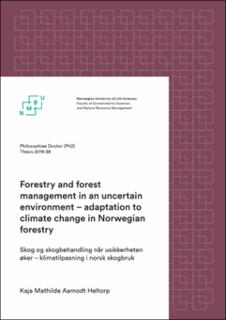| dc.description.abstract | The overall objective of this thesis is therefore to study whether, how, and why (not) risk and uncertainty related to climate change may (or may not) influence the forest management strategies of forestry decision-makers who own or manage non-industrial private forest holdings in Norway.
To reach this objective, we collected data through focus group interviews and a questionnaire.
The 10 focus groups constituted of altogether 54 participants who owned or managed forests or advised owners and managers on forest management in Southeastern Norway. The participants were requited with the assistance of administrative staff in forest owner associations operating in the area.
The interview-guide we used was based on published research articles on climate change adaptation. However, because of a semi-structured design, the frames were still very open and allowed for the participants to discuss rather freely. The interviews was recoded, transcribed, coded and analyzed and this data underlies two of the research papers in this thesis.
The second data-collection was a questionnaire distributed to randomly drawn members of forest owners association’s in Norway and Sweden. The questionnaire was relatively comprehensive, with questions about for example climate change beliefs, experiences an observations, risk-perceptions, need for advice and adaptive climate management. The questionnaire received 1745 replies, which constitutes a response rate of approximately 17.5%. The data from the questionnaire underlies two of the research papers in this thesis.
Taken together, the data collected through this thesis does not much reason to assume that Norwegian forests and forestry at present are undergoing any large-scale proactive adaptation process. In the focus group interviews, most participants signaled that they were rather opposed to changing tree-mixture and forest structure. However, they were still reactively adapting to changes. The managers for example talked about how they now, because of the conditions (i.e ground moisture) emphasized flexible harvest planning so that there always were alternative if conditions in some stands did not allow harvest to continue. Increased focus on road surveillance and maintenance, upgrading of culverts, and increased focus on robustness when building new roads were also relatively common, at least among the managers. The implementation of these practices were however driven by experienced need, rather than motivated by wanting to adapt to climate change per se.
The results from the questionnaire supports the results from the focus groups: few respondents had any strong opinions about adaptive management and the most frequent reply when asked to consider 12 adaptive practices was “no opinion”. The large proportion of “no opinion” makes it challenging to conclude on how climate change is likely to impact forestry in the future, since few respondents neither rejected nor confirmed most practices.
The focus group participants gave a number of reasons for not wanting or feeling at liberty, to change their forest management. Many of these reasons were associated with income, efficiency, or technology. They were however also uncertain whether there was an actual need for change, and about the positive effect of changing their forest management.
The results from the questionnaire showed that many respondents, even though they believe climate change would increase the damages in their forests, did not envisage this having a negative effect on their forestry income potential and holding value. It is thus not unreasonable to assume that they experienced the financial risk associated with climate change and therefore also the need for adaptation as relatively low. A large proportion of the respondents had also insured their forests, it is thus possible that they felt they already had secured themselves in the events of damage and loss. | en_US |

